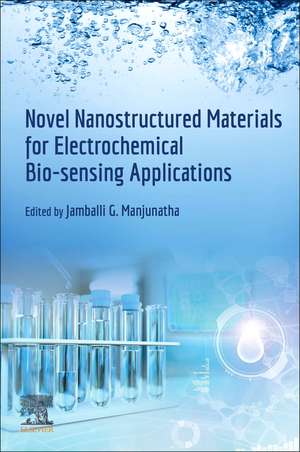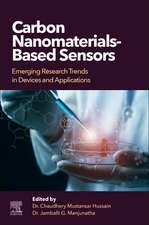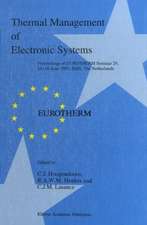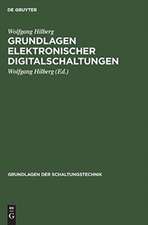Novel Nanostructured Materials for Electrochemical Bio-sensing Applications
Editat de Jamballi G. Manjunathaen Limba Engleză Paperback – 21 noi 2023
By providing its audience with fundamentals, limitations, challenges, future perspectives and practical sustainability, this book will serve as a reference source researchers and engineers within analytical chemistry and electrochemistry.
- Showcases the latest progress in new nanostructured materials, bio-sensing types and applications
- Provides a comparative vision of electrochemical bio-sensing with other biosensors
- Discusses the economics, commercialization, toxicity and life line aspects of electrochemical biosensors
Preț: 905.97 lei
Preț vechi: 1183.65 lei
-23% Nou
Puncte Express: 1359
Preț estimativ în valută:
173.41€ • 188.43$ • 145.76£
173.41€ • 188.43$ • 145.76£
Carte tipărită la comandă
Livrare economică 14-28 aprilie
Preluare comenzi: 021 569.72.76
Specificații
ISBN-13: 9780443153341
ISBN-10: 0443153345
Pagini: 646
Dimensiuni: 152 x 229 mm
Greutate: 0.85 kg
Editura: ELSEVIER SCIENCE
ISBN-10: 0443153345
Pagini: 646
Dimensiuni: 152 x 229 mm
Greutate: 0.85 kg
Editura: ELSEVIER SCIENCE
Public țintă
The primary audience includes researchers, engineers and professors from multidisciplinary fields such as analytical chemistry, electrochemistry and materials science. It will also be helpful for senior-level undergraduates, graduate students and PhD students within these areas.Industrial sector professionals within the area of electrical and electronics engineering, , food quality monitoring, pollution monitoring, electrochemistry and any science related disciplines such as toxic materials, water engineering, circular economy, food quality, quality management, carbon emission, sustainable sensors and materials.
Cuprins
PART 1: Fundamentals, Current advancements in nanostructured electrochemical biosensors
Currently there is a huge progress in nanostructured materials and their applications. Especially for electrochemical bio-sensing applications because nanostructured material has great characteristics like rich surface chemistry, high surface area, surface functionality, compatibility etc.
1. Fundamentals of nanostructured materials and synthetic routes
2. Basic principles, classifications and historical prospectives of electrochemical biosensors
3. Modern trends in carbon nanostructured materials based electrochemical bio-sensing systems
4. Developments in inorganic, organic nanostructured materials based electrochemical bio-sensing
5. Organo-metallic and biomass derived nanostructured materials for bio-sensing applications
6. Comparative review of nanostructured electrochemical bio-sensing with other sensing technologies
PART 2: Fabrication of nanostructured materials based bio-sensing Platforms
Physical, chemical, mechanical characteristics and chemical functionalities of material played an important role in fabrication of electrochemical biosensor. Material characteristics has a great influence on bio-sensing performance. This section includes discussion of methods and materials for preparation of nanostructured biosensors.
7. Approaches in preparation of carbon nanostructured electrochemical bio-sensing devices
8. Fabrication routes for metallic nanostructured electrochemical biosensors
9. Design of nanostructured bio-sensors based on organic and other composite materials
10. Electronic aspects of Electrochemical biosensors: Operation conditions, power requirement, integration ability
PART 3: Applications of nanostructured electrochemical biosensors
Nanostructure material based biosensors have wide spread applications in field of biomedical, environmental, industrial, food and beverages, agricultural, forensic and pharmaceutical analysis. Because these biosensors hold extradinary analytical improvements in terms of low concentration detection, impressive detection and quantification limits. This section includes the applications of nanostructured material biosensors
11. Nanostructured materials based electrochemical biosensor devices for quantification of antioxidants
12. Nanostructured electrochemical biosensors for pesticides, insecticides.
13. Electrochemical bio-sensing for determination of toxic dyes
14. Electrochemical detection of pathogens in water and food samples
15. Electrochemical biosensors for toxic gases monitoring
16. Electrochemical bio-sensing tools for soil nutrient and pH monitoring
17. Nanostructure materials modified electrochemical bio-sensing devices for determination of neurochemicals
18. Real-time utilization of nanostructured biosensors for determination food toxins
19. Nanostructured electrochemical biosensors for estimation of pharmaceutical drugs
20. Advanced nanostructured materials based biosensors in clinical and forensic diagnosis
21. Detection of toxic metals using nanostructured bio-sensing platforms
22. Nanostructured materials based electrochemical biosensors for hormones
23. Nanostructured electrochemical biosensors for determination of amino acids
24. Micronutrients and vitamins electrochemical biosensors based on nanostructured materials
25. Applications of flexible, wearable biosensors for society welfare
26. Safety, health and regulation issues of nanostructured biosensors
27. Advances in green synthesis of nanostructured biosensors
28. Recycling, Toxicity and disposal methods for nanostructured materials based biosensors
29. Economic impact and commercialization limitations of nanostructured electrochemical biosensors
30. Future Sustainability and sensitivity of nanostructured materials based electrochemical biosensors over other technologies
31. Current electrochemical biosensors in market, trends and its future reliability : A Case study
32. A overview stability and life time of electrochemical biosensors
Currently there is a huge progress in nanostructured materials and their applications. Especially for electrochemical bio-sensing applications because nanostructured material has great characteristics like rich surface chemistry, high surface area, surface functionality, compatibility etc.
1. Fundamentals of nanostructured materials and synthetic routes
2. Basic principles, classifications and historical prospectives of electrochemical biosensors
3. Modern trends in carbon nanostructured materials based electrochemical bio-sensing systems
4. Developments in inorganic, organic nanostructured materials based electrochemical bio-sensing
5. Organo-metallic and biomass derived nanostructured materials for bio-sensing applications
6. Comparative review of nanostructured electrochemical bio-sensing with other sensing technologies
PART 2: Fabrication of nanostructured materials based bio-sensing Platforms
Physical, chemical, mechanical characteristics and chemical functionalities of material played an important role in fabrication of electrochemical biosensor. Material characteristics has a great influence on bio-sensing performance. This section includes discussion of methods and materials for preparation of nanostructured biosensors.
7. Approaches in preparation of carbon nanostructured electrochemical bio-sensing devices
8. Fabrication routes for metallic nanostructured electrochemical biosensors
9. Design of nanostructured bio-sensors based on organic and other composite materials
10. Electronic aspects of Electrochemical biosensors: Operation conditions, power requirement, integration ability
PART 3: Applications of nanostructured electrochemical biosensors
Nanostructure material based biosensors have wide spread applications in field of biomedical, environmental, industrial, food and beverages, agricultural, forensic and pharmaceutical analysis. Because these biosensors hold extradinary analytical improvements in terms of low concentration detection, impressive detection and quantification limits. This section includes the applications of nanostructured material biosensors
11. Nanostructured materials based electrochemical biosensor devices for quantification of antioxidants
12. Nanostructured electrochemical biosensors for pesticides, insecticides.
13. Electrochemical bio-sensing for determination of toxic dyes
14. Electrochemical detection of pathogens in water and food samples
15. Electrochemical biosensors for toxic gases monitoring
16. Electrochemical bio-sensing tools for soil nutrient and pH monitoring
17. Nanostructure materials modified electrochemical bio-sensing devices for determination of neurochemicals
18. Real-time utilization of nanostructured biosensors for determination food toxins
19. Nanostructured electrochemical biosensors for estimation of pharmaceutical drugs
20. Advanced nanostructured materials based biosensors in clinical and forensic diagnosis
21. Detection of toxic metals using nanostructured bio-sensing platforms
22. Nanostructured materials based electrochemical biosensors for hormones
23. Nanostructured electrochemical biosensors for determination of amino acids
24. Micronutrients and vitamins electrochemical biosensors based on nanostructured materials
25. Applications of flexible, wearable biosensors for society welfare
26. Safety, health and regulation issues of nanostructured biosensors
27. Advances in green synthesis of nanostructured biosensors
28. Recycling, Toxicity and disposal methods for nanostructured materials based biosensors
29. Economic impact and commercialization limitations of nanostructured electrochemical biosensors
30. Future Sustainability and sensitivity of nanostructured materials based electrochemical biosensors over other technologies
31. Current electrochemical biosensors in market, trends and its future reliability : A Case study
32. A overview stability and life time of electrochemical biosensors
















